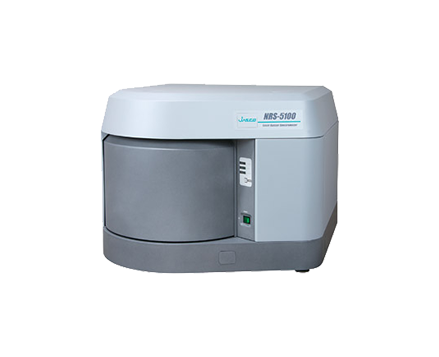Measurement of Diamond-Like Carbon (DLC)
October 8, 2024
Introduction
Diamond-Like Carbon (DLC) is an amorphous carbon material that has an intermediate molecular structure between diamond and graphite. DLC coatings are used to improve abrasion resistance, chemical resistance etc., it is used as a coating for cutting tools, automotive components, medical equipment, optical components and many other products. In recent years, DLC coatings have also been used to improve the gas barrier properties in plastic bottles.
This application note reports the analysis of DLC coated plastic bottles using Raman spectroscopy.
Experimental
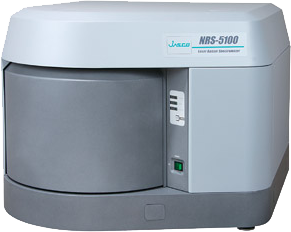
The samples measured were two types of plastic bottle with a visual appearance of different colors as shown in Figure 1. From this point forward, samples from colorless clear plastic bottles shown in Figure 1 are referred as “colored” (left) and samples from the “clear” plastic bottle (right ) are referred as “uncolored”.
Measurements were made of both the inside and outside surfaces of each plastic bottle (upper and lower surfaces as shown in Figure 1) and the Raman spectra were compared.
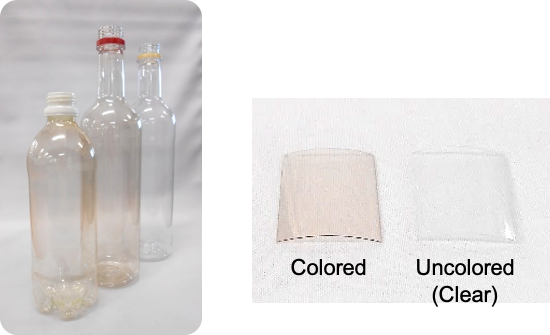
The instrument and measurement parameters are as follows.
Keywords
020-AN-0023, DLC, Diamond-Like Carbon, coating, carbon, amorphous, polyethylene terephthalate
Results
Figure 2 show the results of measurement of both the inside and outside of the uncolored and colored samples. In the case of the uncolored sample, polyethylene terephthalate (PET) peaks were obtained from both inside and outside measurements. For the colored sample, different spectra were obtained between the inside outside measurements. The difference spectrum from the colored sample is shown in Figure 4. A database search identified the different spectrum as DLC. PET was found on the outside of the colored sample and on the inside surface DLC was found in addition to PET, this confirmed that the inside of the plastic bottle was coated with DLC.
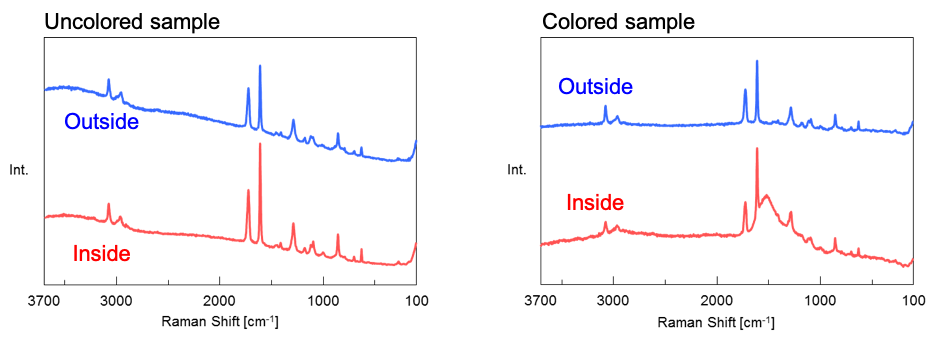
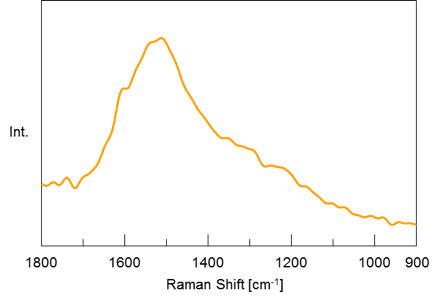
(Inside – Outside)
Furthermore, the quality of the DLC coating can be evaluated from its spectrum; the D band (sp3 bonds in the material lattice) and G bands (sp2 bonds in the material lattice) can be deconvolved using curve fitting as shown in Figure 4, from this it is possible to evaluate characteristics such as abrasion resistance from the peak positions, half widths, peak ratio etc.
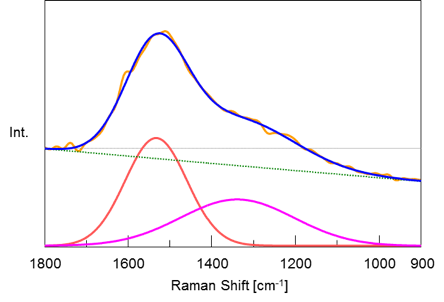
Conclusion
In this application note, we introduced an example of measurement of a DLC coated plastic bottle by Raman spectroscopy. In addition, Raman can be used to evaluate the characteristics of DLC used for various tools and magnetic disks with non-destructive and non-contact testing.
| Measurement Conditions | |||
| Main Unit | NRS-5500 Raman spectrometer | Objective Lens | 100x |
| Ex Wavelength | 532 nm | Accumulation | 2 times |
| Exposure Time | 90 seconds | ||
Remarks
The typical thickness of DLC coatings on plastic bottles is around 10 nm to several tens of nanometers. In future, it is likely that DLC coatings will be made thinner in order to reduce material costs. If the DLC thickness is too thin, it may be difficult to detect by Raman spectroscopy. This trend is seen not only for the coatings on plastic bottles, but for the DLC industry as a whole.
The measurement parameters for slit and aperture were as follows:
Slit: j25 µm Aperture: j40 µm
In this sample measurement, Diamond-Like Carbon(DLC) film could be detected even using a large slit and aperture. But in this application note, the results of high spatial resolution are shown in order to improve the quality of DLC material detection.
The spectra in Figure 2 show that even though the plastic bottles samples were made from the same material (polyethylene terephthalate), the baselines were different between the uncolored and colored samples. In Raman spectroscopy, the presence of slight amount of impurities can cause fluorescence, it is assumed that a slight difference occurred in the material due to a variation the production process.
We recommend that the dedicated Carbon analysis program is used for curve fitting of multiple spectra (*.jws spectrum data files). This program can be conveniently used to batch process multiple data.
| System Configuration | ||||
| Model | Description | P/N | Remarks | |
| Main Unit | NRS-5500 | Raman Spectrometer | 7119-J051A | Laser: 532 nm In this application note a 100 mW laser was used, however good sample measurement can be made using the standard 50 mW laser. |
| Accessories | RXY-478B | Automatic XYZ stage | 6947-J478B | |
| RHG5-600B500 | 600 gr/mm grating | 6947-J293A | Measurement can be made using the standard grating (1800 gr/mm), however we recommend the optional 600 gr/mm grating with a wider measurement range. |
|
Featured Products:

Measurement of Diamond-Like Carbon (DLC)
Introduction
Diamond-Like Carbon (DLC) is an amorphous carbon material that has an intermediate molecular structure between diamond and graphite. DLC coatings are used to improve abrasion resistance, chemical resistance etc., it is used as a coating for cutting tools, automotive components, medical equipment, optical components and many other products. In recent years, DLC coatings have also been used to improve the gas barrier properties in plastic bottles.
This application note reports the analysis of DLC coated plastic bottles using Raman spectroscopy.
Experimental

The samples measured were two types of plastic bottle with a visual appearance of different colors as shown in Figure 1. From this point forward, samples from colorless clear plastic bottles shown in Figure 1 are referred as “colored” (left) and samples from the “clear” plastic bottle (right ) are referred as “uncolored”.
Measurements were made of both the inside and outside surfaces of each plastic bottle (upper and lower surfaces as shown in Figure 1) and the Raman spectra were compared.

The instrument and measurement parameters are as follows.
Results
Figure 2 show the results of measurement of both the inside and outside of the uncolored and colored samples. In the case of the uncolored sample, polyethylene terephthalate (PET) peaks were obtained from both inside and outside measurements. For the colored sample, different spectra were obtained between the inside outside measurements. The difference spectrum from the colored sample is shown in Figure 4. A database search identified the different spectrum as DLC. PET was found on the outside of the colored sample and on the inside surface DLC was found in addition to PET, this confirmed that the inside of the plastic bottle was coated with DLC.


(Inside – Outside)
Furthermore, the quality of the DLC coating can be evaluated from its spectrum; the D band (sp3 bonds in the material lattice) and G bands (sp2 bonds in the material lattice) can be deconvolved using curve fitting as shown in Figure 4, from this it is possible to evaluate characteristics such as abrasion resistance from the peak positions, half widths, peak ratio etc.

Conclusion
In this application note, we introduced an example of measurement of a DLC coated plastic bottle by Raman spectroscopy. In addition, Raman can be used to evaluate the characteristics of DLC used for various tools and magnetic disks with non-destructive and non-contact testing.
| Measurement Conditions | |||
| Main Unit | NRS-5500 Raman spectrometer | Objective Lens | 100x |
| Ex Wavelength | 532 nm | Accumulation | 2 times |
| Exposure Time | 90 seconds | ||
Remarks
The typical thickness of DLC coatings on plastic bottles is around 10 nm to several tens of nanometers. In future, it is likely that DLC coatings will be made thinner in order to reduce material costs. If the DLC thickness is too thin, it may be difficult to detect by Raman spectroscopy. This trend is seen not only for the coatings on plastic bottles, but for the DLC industry as a whole.
The measurement parameters for slit and aperture were as follows:
Slit: j25 µm Aperture: j40 µm
In this sample measurement, Diamond-Like Carbon(DLC) film could be detected even using a large slit and aperture. But in this application note, the results of high spatial resolution are shown in order to improve the quality of DLC material detection.
The spectra in Figure 2 show that even though the plastic bottles samples were made from the same material (polyethylene terephthalate), the baselines were different between the uncolored and colored samples. In Raman spectroscopy, the presence of slight amount of impurities can cause fluorescence, it is assumed that a slight difference occurred in the material due to a variation the production process.
We recommend that the dedicated Carbon analysis program is used for curve fitting of multiple spectra (*.jws spectrum data files). This program can be conveniently used to batch process multiple data.
| System Configuration | ||||
| Model | Description | P/N | Remarks | |
| Main Unit | NRS-5500 | Raman Spectrometer | 7119-J051A | Laser: 532 nm In this application note a 100 mW laser was used, however good sample measurement can be made using the standard 50 mW laser. |
| Accessories | RXY-478B | Automatic XYZ stage | 6947-J478B | |
| RHG5-600B500 | 600 gr/mm grating | 6947-J293A | Measurement can be made using the standard grating (1800 gr/mm), however we recommend the optional 600 gr/mm grating with a wider measurement range. |
|
Keywords
020-AN-0023, DLC, Diamond-Like Carbon, coating, carbon, amorphous, polyethylene terephthalate

 Download This Application
Download This Application